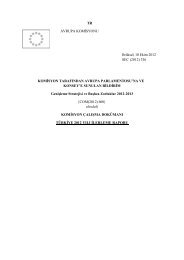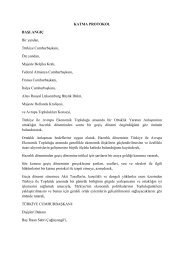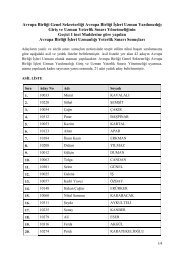2010 ilerleme raporu - Avrupa BirliÄi BakanlıÄı
2010 ilerleme raporu - Avrupa BirliÄi BakanlıÄı
2010 ilerleme raporu - Avrupa BirliÄi BakanlıÄı
You also want an ePaper? Increase the reach of your titles
YUMPU automatically turns print PDFs into web optimized ePapers that Google loves.
the sharp drop in real interest rates in recognition of Turkey’s solid fundamentals. At the same<br />
time, potential growth in Turkey is being held back by high inactivity and insufficiently<br />
broad-based productivity growth. Overall, the crisis did not jeopardise the functioning of<br />
market mechanisms.<br />
Human and physical capital<br />
The educational reform programme, which is a key part of the National Development Plan<br />
(2007-2013), is being implemented. It sets two key priorities for education, modernisation and<br />
reform: increase the responsiveness of education to demand and enhance the educational<br />
system. In <strong>2010</strong>, the challenges remain significant. Although there has been some progress<br />
and the top students in Turkey are performing well, the vast majority of Turkish students<br />
perform at the lowest proficiency levels in basic skills and problem-solving. Participation in<br />
higher education remains low by international standards. Around 44% of 20- to 24-year olds<br />
go to university, 8 percentage points more than in 2006, while only 1.5% of school-age<br />
children fail to finish primary school, compared with 10% in 2006. Overall, reforms and<br />
increased spending on education are obviously having some positive impact on educational<br />
attainment, but significant problems persist.<br />
During the crisis, investment decreased and gross fixed capital formation (GFCF) fell by<br />
around 3% in 2009 to about 20% of GDP, but growth resumed by as much as 22% in the first<br />
half of <strong>2010</strong>. Private capital formation totalled around 15% of nominal GDP. FDI inflows<br />
held up relatively well in 2009 helped by the privatisation of the electricity grids but fell by<br />
about 20% in the first half of <strong>2010</strong> compared with a year earlier. At the same time, their<br />
composition improved, as more than three quarters went into utilities and manufacturing. For<br />
many years infrastructure investment has been hampered by the need to consolidate public<br />
finances and the failure to cut lower-priority spending. Inadequate infrastructure is<br />
increasingly affecting economic activity. Though in 2009 and <strong>2010</strong> some ─ albeit modest ─<br />
progress can be reported on infrastructure, in particular roads and oil pipelines, there is a risk<br />
that inadequate infrastructure, including for power supply, could hamper the economic<br />
recovery. Gross electricity consumption growth has averaged some 7% in each of the last few<br />
years, and extra power-generating capacity is being constructed, albeit with some delays.<br />
Although the official government target was to increase research and development<br />
expenditure to 2% of GDP by <strong>2010</strong>, R&D expenditure remains much lower, on just 1.4%.<br />
Overall, some limited progress was made on upgrading the country’s human and physical<br />
capital.<br />
Sectoral and enterprise structure<br />
The independence of the regulatory and surveillance agencies has been largely preserved.<br />
Market liberalisation has not advanced in agriculture, whereas some progress has been made<br />
in the pricing mechanisms for the energy sector. The sectoral shift from agriculture to services<br />
and industry was reversed by the slowdown in economic activity. The share of agriculture in<br />
overall employment increased from 23.7% to 24.7% between December 2008 and December<br />
2009. The share of services stabilised at 50%. On the other hand, both industry and<br />
construction saw their relative shares of total employment decline by a combined total of<br />
1.5%. The quality and frequency of data on small and medium-sized enterprises (SMEs)<br />
remained poor. Various new initiatives have been launched to improve access to finance for<br />
SMEs. However, the share of SMEs in total banking sector loans decreased from 23% at the<br />
end of 2008 to 21.4% by December 2009. For instance, a new guarantee fund for SMEs was<br />
part of the stimulus packages with the aim of alleviating the impact of the crisis on SME<br />
EN 43 EN
















